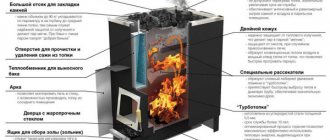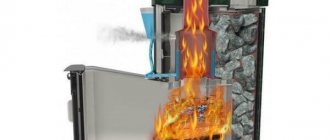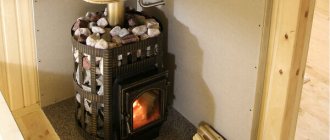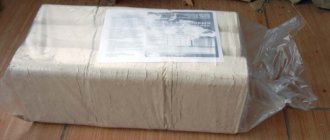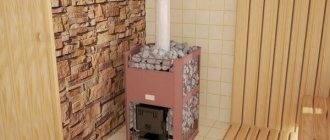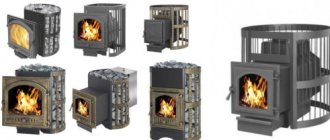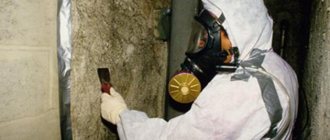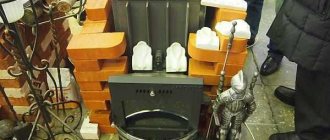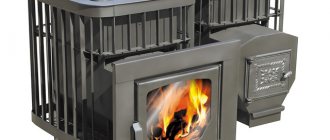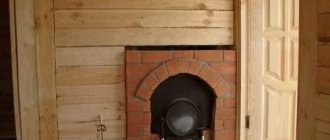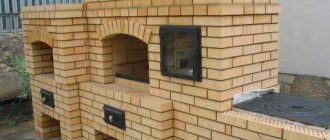When talking about repairing sauna stoves, we most often mean brick devices. As you know, their laying requires special knowledge and experience. If the work was carried out by a qualified stove-maker, the structure will last for decades. However, nothing on earth lasts forever, therefore, sooner or later, any sauna stove begins to require repair. It’s quite expensive to call a stove repairman every time, which means you need to learn how to fix some problems yourself.
Repair of a sauna stove: what happens?
Repairs are divided into three categories:
- Current;
- Average;
- Capital.
The reason for each is the extreme conditions in which all areas of the furnace “work”. This is especially true for the firebox and chimney. As you know, an increase in temperature entails a change in the volume of the material, so a heated brick is always slightly larger than a cold one. Different volumes cause the formation of cracks on the surface of the stove and masonry seams, as well as dark patterns around iron parts (dampers, grates, doors).
Chimney cleaning
The chimney must be cleaned regularly, at least once a year. If the stove is used only in the summer, for example, in a country house where no one lives in winter, then it is better to clean the chimney openings before the first ignition after a long period of standing.
One of the cleaning options is burning aspen wood. Aspen gives the highest temperature when burning and, as it were, burns away the soot. This option is suitable if you notice that the draft is poor and a little smoke enters the room.
If the stove is smoking and there is a lot of smoke in the room, then you need to approach cleaning more thoroughly. To do this, open the special doors leading to the chimney and remove the carbon deposits with a dustpan and broom. Sometimes removable stones are installed instead of doors. They need to be cleaned from the plaster and removed by hand, then clean the chimney opening. After cleaning, you can rinse with water using a brush.
Another option is cleaning from the roof. We also open the doors (take out the bricks), climb onto the roof, and push the carbon deposits and debris from top to bottom with a large, strong stick.
Maintenance
Basically, minor repairs are caused by a lack of traction, which can be caused by:
- Accumulation of cold air in the chimney due to a long break in the operation of the stove;
- Chimney clogged with soot.
Solving the first problem is quite simple: you need to take not paper for ignition, but dry fuel or a piece of rubber. Under no circumstances is it recommended to use kerosene and similar liquids.
Cleaning a chimney requires more complex actions:
- Light the stove with alder or aspen wood;
- Throw a handful of table salt into the fire and quickly close the damper.
If this does not help, then the chimney will have to be cleaned manually.
Destruction of brickwork
The stove may begin to smoke due to the formation of cracks in the brickwork. They are covered with a mixture of clay and sand, to which salt and powdered asbestos fiber are added (100 g per 3 liters of solution). The last element is necessary to ensure the elasticity of the mixture. The resulting composition should have a medium viscosity (too oily will crack when drying, and too dry will not provide the necessary strength).
If you don’t have time to make your own mixture, you can purchase a ready-made one and mix it according to the instructions.
Replacing burnt bricks
If a brick falls out or burns out, it must be replaced with a new one:
- Thoroughly clean the installation site from dust and old mortar;
- Moisten with water and place the pre-mixed clay cake;
- Dip a new brick in water and coat the top and sides with clay;
- Carefully insert it into the prepared place.
Types of repairs and signs of the need for repair of stove products
It often happens that even a new stove, fireplace, barbecue or barbecue complex, built by amateurs or according to instructions from the Internet, smokes, does not heat up well, crumbles, etc. Such stoves, most often, were created by the owners themselves, or by unscrupulous and inexperienced builders.
The main causes of cracks and mortar leakage from joints:
- excessively thick masonry joint (more than 3-5 mm) - a mistake inherent in masons and novice stove makers
- incorrectly selected masonry mixtures (we use only high-quality and time-tested mixtures in our work: Kostroma stove of the Makarovs' house, Plitonit - SuperKamin and heat-resistant Terracotta clay-chamotte)
- Inadequate filling of seams is a mistake inherent in masons, blunderers and novice stove makers
- failure to comply with compensation thermal gaps during the work process is a mistake inherent in masons and novice stove makers
- improper mixing of mixtures
- non-compliance with temperature conditions during work
- adding cement to speed up masonry
- natural operational burnout in the seams in the firebox
- lack of firebox lining
- incorrect product design
- local overheating
- improper operation
We recommend reading the article on the proper operation of stove products.
The main reasons for smoking of stoves, fireplaces, barbecue complexes:
- the product has not been used for a long time
- condensation in a cold chimney pipe
- draft, damp, rotten, dirty firewood
- insufficient oxygen supply for proper combustion
- “overturning” of thrust or periodically occurring reverse thrust
- the vent is clogged with ash
- overgrowing of chimney pipes and ducts with soot
- a foreign object got into the chimney pipe (for example, a bird's nest; it collapsed, a delaminated brick fell out)
- insufficient chimney pipe height
- nearby tall trees
- incorrect chimney design (including small cross-section of channels)
- Incorrect combustion door size - firebox * channel cross-section
- incorrect proportion of the sizes of the fuel chamber and the blower chamber
- depressurization of brickwork - formation of cracks due to the long service life of the product
- constructive miscalculations of the master
- lowered entrance to the “well”
- the smoke collector (smoke chamber) is incorrectly designed and constructed
- small size of heat in Russian ovens
- the proportions of the fireplace or barbecue are incorrectly selected
- the smoke collector (smoke chamber) is filled with steps
- missing or greatly reduced smoke tooth
Repair of medium complexity
This group includes the replacement and strengthening of sauna stove parts.
You can fix a loose door by dismantling the brickwork next to it and re-fixing the door with steel wire.
The burnt-out grate is removed and replaced with a new one, which should not lie close to the bricks. It is necessary to leave a gap of 5 mm between the masonry and the grate and fill it with sand.
Leaky pre-furnace sheets cannot be repaired. They are simply replaced with new ones, not forgetting to place a piece of felt soaked in liquid clay underneath.
CAUSES OF PROBLEMS
Repair of a sauna stove can be caused by several reasons:
- Inadequate care
Irregularities in the operation of the furnace occur as a result of the formation of soot. Plaque settles on the internal surfaces, reducing the heat transfer of the structure and destroying its continuity.
The operation of the heater can be disrupted by the decomposition of stove stones, which forms a dense mass of debris at the bottom of the system and prevents high-quality heating.
- Wear of components
The furnace door that is secured with steel wire wears out the fastest. Another problem is the decomposition of the fixing solution, which threatens the appearance of small cracks, exposed seams and disruption of the furnace draft.
The most serious flaw in this group is the partial fracture of bricks, which appears as a result of using unsuitable material.
- Misuse
Wear and tear of the structure occurs as a result of improper fuel placement and the use of flammable substances (diesel fuel, gasoline).
- Design errors
The most serious reason requiring a complete redesign of the structure. It is expressed in the form of a complete lack of draft, deep cracks in the brazier, minimal heating of the external walls.
In some cases, repair of a sauna stove may be caused by switching from classic fuel to gas.
Major renovation
Overhaul includes restoring full functionality and replacing broken parts.
Chimney
The destroyed masonry needs to be sorted out. If it is in normal condition, then the chimney is simply plastered.
Lining
When replacing it completely, do not touch the main stove masonry. The stove must be disassembled from the bottom of the ash pan to the top point of the firebox. Do not touch the oven fins. Remove the remaining mortar and lay out a new lining without tying it to the bricks of the walls. The thickness of the seams should not exceed 2 mm.
Strengthening the frame
As already mentioned, places where masonry mortar spills out or small cracks need to be covered with a new mixture. But in some cases, there are so many cracks that they cover the entire stove. Simple coating will not help here.
Of course, it is better to go through the furnace completely, but if there is no time for this, then repairs are performed as follows:
- Horizontal channels 1.5-2 cm deep are punched into the oven;
- The “web” of channels should encircle the entire furnace, since the wire laid along it will tighten the entire frame of the structure;
- Insert the wire into the groove and tighten it well. To do this, you need to carefully twist the wire in several places using a thick nail;
- Plaster the stove again.
How to extend the life of the furnace?
- In order for the stove to delight you with warmth and beauty for a long time, you must follow the following rules:
- Clean the chimney regularly.
- Regularly clean surfaces and grates from burning and debris.
- Do not burn household waste in the stove.
- Inspect the oven. If you notice cracks and chips, seal them with a special solution.
- Follow the rules: use only special fireproof materials (fireclay brick, fireclay clay, fireclay mortar) to build and repair a stove for your summer cottage.
Watch the video: “Do-it-yourself brick oven repair”
Spare parts
According to the recommendations of manufacturers of equipment for saunas and hammams, original parts must be used during repairs. This is a guarantee of restored functionality and reliable operation for many years.
Service is the official supplier of the brands Harvia, Helo, Tylo and other manufacturers. We offer original spare parts and consumables with a guarantee.
- Harvia heating elements
- Harvia spare parts
- Tylo spare parts
- Helo spare parts
Prices for service and repair services
| No. | Name of works | Cost, rub |
| 1 | Diagnosis of a malfunction in a service center: | |
| — electric heaters | 1200 | |
| - control panel | 1200 | |
| — steam generator | 1800 | |
| — Combi electric heaters with remote control | 1800 | |
| 2 | Control panel repair | |
| replacing the display board (at the service center) | 600 (220) | |
| replacing the power supply board (at a service center) | 3000 (600) | |
| 3 | Repair of electric heaters | |
| replacing the thermostat (at a service center) | 3600 (1200) | |
| replacing the timer (at the service center) | 2400 (600) | |
| Replacing heating elements: | ||
| — mounted electric heaters (without evaporator): | ||
| 1-3 pcs. (at the service center) | 3600 (600) | |
| — floor electric heaters: | ||
| 1-3 pcs. (at the service center) | 4800 (1200) | |
| 4-6 pcs. (at the service center) | 4800 (1800) | |
| 7-12 pcs. (at the service center) | 4800 (1800) | |
| 4 | Repair of the evaporator in Combi electric heaters: | |
| - dry cleaning, washing | 2400 | |
| — installation of a repair kit (in the service center) | 3600 (1800) | |
| — replacement of the heating element (at the service center) | 3600 (1800) | |
| — replacement of sensors (overheat protection thermostat or operating thermostat) | 1800 | |
| 5 | Steam generator repair: | |
| replacing heating elements, cleaning the tank | 6000 — 10800 | |
| replacing the power supply board | 3600 | |
| 6 | Replacing the electric heater control panel (dismantling/installation) | 4800 |
| 7 | Replacing the temperature/humidity sensor (WX232/WX325) | 600 |
| 8 | Replacing the WX236 humidity sensor | 1200 |
| 9 | Typical installation and connection of an electric heater (KIP, KV, M, etc.) without a remote control: installation and connection of the electric heater to pre-wired wiring, checking operation. | 3600 |
| 10 | Typical installation and connection of an electric heater with a remote control: installation and connection of an electric heater, control panel, sensors to pre-wired wiring, checking operation. | 6000 without power unit |
| 7200 with power block | ||
| 11 | Typical installation and connection of an electric heater with an evaporator and a remote control: installation and connection of an electric heater with an evaporator and a remote control to pre-installed wiring and water supply, laying stones (if necessary), checking operation. | 7200 without power unit |
| 8400 with power block | ||
| 12 | Typical installation and connection of the control panel: mounting the remote control, connecting pre-wired wiring, checking operation | 3600 without power block |
| 6000 with power unit | ||
| 13 | Assembly and installation of IR cabins | |
| single | 6000 | |
| double | 8000 | |
| 14 | Dismantling and installation of furnace fencing | 1000 |
Consultations, assistance and detailed information on service can be found by calling 8 (929) 659-79-44
Design of Feringer stoves with a closed heater
In general, the firebox is formed mainly by stamping and bending methods, and has a minimum of seams. The seams are located in places with low temperature loads. All furnace elements are made of stainless steel with 17% alloy metal content.
In stoves with a closed heater, a cylindrical container for stones rests on the base of the stove and covers the firebox on all sides (except for the front part, where the extension or firebox door is installed). To regulate the air flow passing through the heater, there is an adjustable damper. With its help, you can reduce or increase the heating rate of the steam room.
Construction of a furnace for a Feringer bath with a closed heater
When the required temperatures are reached, the damper closes completely or almost completely. The temperature is stabilized and the steam room conditions are maintained in the specified mode.
A smoke tooth is installed in the upper part of the firebox. This is a metal piece curved in the shape of the letter “L” at the top of the firebox. It allows you to twist streams of smoke and flame into a spiral. Because of this, the walls of the firebox warm up better, and the stones warm up from it. This tooth gives another positive result: the flame rises in the pipe only 30-70 cm (in stoves of a conventional design, the height of the flame in the pipe exceeds a meter, and sometimes one and a half to two).
There is an adjustable barrier above the door (1) and below it (2)
The burning speed of wood can be changed using two dampers. One is located above the firebox door, the second below it. It is advisable not to close the upper damper completely: it ensures that there is no soot on the glass. Always leave at least a minimum gap of a couple of millimeters, and the glass on the door will always be clean.
These two dampers regulate the amount of air supplied to the firebox. The more air, the more actively the wood will burn. This mode is necessary at the stage of heating the steam room and stones. Then, when the temperature is close to the required one, they cover themselves and the wood smolders, maintaining the temperature of the stones and practically stopping the heating of the steam room.
Getting steam
Deep inside the heater is a device called a steam gun. This is an L-shaped tube with holes. Another tube is welded to it, which goes to the top of the heater. Water is supplied to it and converted into steam.
This is how a steam gun works
Through small holes in the horizontal tube, water flows into the hottest part of the heater - onto the lower stones. Their temperature is 500-550°C. As a result, tiny droplets are formed, which have a high temperature at the outlet. They are very small, they are almost invisible. This state of steam is called “light”. Probably because after vaping you feel light in your body and never have a headache.
The atmosphere in a steam room consists of many components. The air and walls warm up from the radiation of the stove body and pipe, from the steam that is supplied to the heater. You need to change the temperature in the steam room by manipulating the modes of these elements. There are dampers/gates for this.
How to adjust the combustion intensity and heat transfer of the housing has already been explained (using the valves near the door). It is also necessary to control the air flow through the chimney convector. For this purpose, there is also a valve/gate in its upper part. By moving its handle to the right/left, you open/close, completely or partially, the lumen of the air tubes.
Devices for adjusting combustion intensity
The new Feringer stoves of the Lamel series have another powerful tool: the heater ventilation valve. At the initial stage, when the stones warm up, it is closed. The heater in this position is unventilated and the stones heat up to high temperatures. Then, to quickly reach the desired temperature, the valve opens.
While this is happening, the walls, floor, ceiling, and shelves are warming up in the steam room. As bath experts say: the steam room is infused. The temperature background of all its parts is equalized. It is in this state of affairs, when heat comes from the walls, and from the shelf, and from the ceiling, that the body warms up deeply. There is no heat. You feel only an even warmth that does not burn, like in a dry air vent, but envelops you, warming you up.
This is a live steam gun
The temperature drops slightly. But if it is within the normal range (50-55°), there is no need to raise it again: with each supply of steam it will jump by about 5°C. So, if you raise the humidity, you will also raise the temperature. And before steaming with brooms, you need to warm up two or three more times. During this time, it will grow another 10-15 degrees.
There are fewer requirements for sauna stoves, and their structure is simpler. Their main task is to quickly heat the steam room to the required temperature, and then ensure its maintenance.
Design of sauna stoves from Fehringer
There is almost no steam in dry-air steam rooms; if you occasionally add one or two ladlefuls, then more for aromatization. Therefore, the volume of the heater is small - it should be enough to heat the steam room. They do not perform any other functions.
Adjusting the combustion intensity is the same as in sauna stoves: a valve above and below the fuel door.
How to properly heat a sauna with a metal stove with wood
A little practice is enough to master the art of professionally lighting a stove in a steam room. All you have to do is strictly follow the instructions provided.
The process begins with preparation. It is necessary to restore order and remove any items that will not be used during the procedure. Next comes a stage called burning. Each oven has its own characteristics, so the principle of the approach will vary.
If you violate the rules of kindling, quite serious consequences can arise: from the formation of too heavy steam to heat stroke or, even worse, fire.
Checking and preparing basic elements
First of all, we pay attention to the stones. They should be washed to remove soot. Then we move on to the water boiler. If you have it, then it should never be empty. Even in cases where it will not be used by anyone while you are in the steam room. An empty boiler may not withstand high heat and will burst. After this information, questions about whether it is possible to heat a bathhouse without water should not arise.
In the process of taking procedures, regularly check the fluid level; if it becomes critically low, raise it. This will not only ensure the safety of the entire structure, but will also ensure your safety while you are inside the steam room.
Next we check the traction. We close the doors that go into the room and release the valves of the firebox, vent and smoke hood. To understand whether oxygen is flowing to the stove, you simply light a match and bring it closer to the ignition channel of the structure. Just watch the movement of the flame, it will react instantly when there is normal draft.
How to heat a wood-burning sauna
Prepare small wood chips, which can be obtained by separating thin, small pieces of one log. Place them in the firebox on pre-lined newsprint or small wood chips that need to be set on fire. Then close the door and wait a few minutes. Remember not to use any flammable liquids. After just a short period of time, you will hear the characteristic sound of a flame.
Loading firewood
After the fire has appeared, you need to open the firebox and fill it with wood. It's important not to make it too tight. Carefully, leaving small gaps, place the logs at a short distance from the door.
It usually takes about 3 hours to heat a sauna - in warm weather and about 6 hours with the onset of the first cold snap. It is worth understanding that these indicators are variable, it all depends on the volume of the water tank, the number of stones, and what kind of stove you use. Insulation is one of the main factors in preparing a steam room! VÖHRINGER employee
It is worth abandoning any alternative types of fuel, garbage or other waste. Most of them release hazardous substances when ignited. Accordingly, no one wants to breathe it.
Steam laboratory
The Vohringer plant has been operating for more than 20 years, creating both stoves for Russian baths and stoves for Finnish saunas, heating and cooking stoves, as well as chimneys and tanks.
We are a close-knit team of engineers, programmers, machine operators, mechanics, working on modern laser, waterjet, robotic, and welding equipment. By introducing advanced technologies, using the best available materials, we make these stoves for you. Our company has patented and used more than 50 proprietary inventions aimed at improving the consumer qualities of our products.
Thanks to modern equipment, we draw conclusions not from our own feelings, but on the basis of real physical data! At Vohringer we regularly research, experiment and invent, achieving improvements in combustion, minimizing heat loss, improving the steam generation process and making the operation of our stoves as convenient as possible.
For these purposes, there is a laboratory with a working steam room on the territory of our plant.
Here we check all our new products produced at the enterprise. The technical equipment of the laboratory allows us to measure the temperature and humidity of stones at different levels of the heater, firebox and steam room. Using gas analyzers, our specialists monitor technical processes that help increase the efficiency of the furnace!
How to store kindling material
Just leaving the wood in a pile on the grass is a bad idea because it will become damp and moldy. It is quite convenient to stack the logs next to the wall of the house in such a way that the roof canopy protects them from any weather conditions. The problem is that not everyone wants to clutter the facade, especially when there is a lot of material.
The easiest and most effective way is to build a small shed or so-called firewood shed. As an example, it is created as follows. Bricks are selected and placed in two rows at a distance of 600 mm from each other, plank flooring is laid on top and bottom. Actually, this stand is used for storage. Additionally, the structure can be strengthened with transverse wooden posts or made into something like walls. In order to ensure good ventilation, it is preferable to lay the floor not solid, but to leave small gaps between the boards.
What types of wood are most often used?
You need to understand that different types of wood material are characterized by their density and heat output. These indicators directly affect how much fuel is needed to achieve the required temperature level. We will consider trees that grow in Russia. The hornbeam produces the most heat, the poplar the least. As a result, you will need very little of the first type, and an impressive amount of the second.
Obviously, hornbeam does not grow everywhere, so sometimes you will have to replace it with what you can find in your area. In this case, you need to take into account the fact that not the first tree you come across will do. The most common species are alder and birch. They burn excellently, and what is important, when heated, they release aromatic essential oils. Pine wood is also ubiquitous, but its problem is that when it burns, it releases resin, which will clog the chimney.
The choice of wood is important, but you still need to figure out how to properly heat a sauna with wood. We will also dwell on this topic in detail further.
The best options to consider as fuel are:
- Hornbeam is an ideal option. It burns for a very long time and produces very little smoke.
- Acacia - is characterized by the fact that it allows you to maintain a constant level of heat in the firebox.
- Linden - it is not very dense in its structure, so it burns quickly without leaving behind hot coals.
- Oak is an excellent option; it fills the room with a pleasant aroma while burning and gives off enough heat. The cost of such firewood is high, however, they can be stored for a very long time and do not change their qualities.
- Birch - burns quickly and evenly, releases substances into the air that allow you to clean the steam room from harmful microorganisms. It is better to use those logs that were prepared quite recently. Watch the amount of firewood thrown into the stove; when there is a lot of smoke, tar begins to be released, which clogs the chimney.
- Pine or spruce. They should be used as a last resort, when there is simply no other material. Resin contaminates the walls of the smoke exhaust pipe quite quickly. When figuring out what kind of wood you can’t use to heat a bathhouse, this option is first on the list.
Once you have decided on a specific type of fuel, all that remains is to learn how to prepare it correctly. Of course, this option is more relevant for those who prefer not to buy ready-made logs
Summing up
In this article, we talked in detail about how to light a sauna and what kind of wood is best to heat it with, and looked at all the features of this process. Now all you have to do is prepare a sufficient amount of material and properly prepare the heating device for operation. If you have any additional questions, you can always ask the specialists at the time of purchasing the stove. They will explain to you in detail all the intricacies of the device of a particular model and tell you how to make the product last as long as possible. Modern metal structures are made with high quality; it is enough to follow basic rules such as timely cleaning of the firebox from ash, regular inspection of the chimney and compliance with operating techniques.
Please note that this article is for informational purposes only and under no circumstances constitutes a public offer as defined by the provisions of Article 437 (2) of the Civil Code of the Russian Federation.
The main problems of a brick kiln
The most common problems that arise when using a brick oven include the following:
- Reduced cravings. This leads to slower burning of the fuel and slower heating of the stove itself. If the draft is poor, smoke can flow from the firebox into the room through leaks in the firebox door. The same thing happens when the wind increases outside, when the wind blows smoke into the chimney. This problem can cause the appearance of carbon monoxide, a deadly, colorless, odorless substance that accumulates indoors.
- The destruction of masonry in certain places, the appearance of cracks through which combustion products escape, and the loss of heat necessary to warm up the stove.
- Uneven heating of different areas of the oven.
- Rapid cooling of the stove after combustion in the firebox stops. The oven does not hold heat and cools down quickly.
- Loosening or falling out of the combustion door fastening parts.
Any of these defects requires attention and, if possible, rapid elimination. How to do this and what can cause them to appear, read below.

